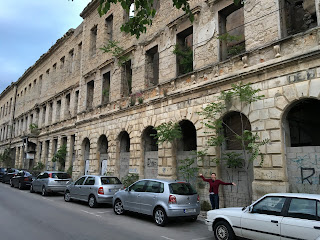Our first order of business was to pick up the rental car. Though Curtis had been mentally preparing to drive on the other side of the street, it turns out they drive on the same side of the street that we do in the U.S.
My job had been to read up on the driving conditions. Ginette had read that the conditions were bad and all of my reading said that there were a lot of mountainous areas, it rained a lot, there are no rail guards on the side of the roads and everyone speeds. We had no rain. It was mountainous. There were plenty of rail guards, and people really do drive way over the speed limit.
I told Curtis what to expect, so follow the speed limit he did, much to the annoyance of the locals. When he decided to pull over to let them pass, about 15 cars passed us. It was funny.
We drove the two hour drive to Mostar. Here are some pictures from the lovely drive. The part I didn't sleep through. My sister's shoulder was useful.
This is how the hay is left to dry - piles with a pitch fork or something like it through the top.
Pictures taken while driving never turn out well, but you get the picture.
When we got to Mostar, we had trouble finding our Airbnb. If I had taken this picture a few minutes earlier you could have seen just how adorable these guys were. Andrea is asking them for directions and they were all bent towards her trying to help her out. Only one of them spoke English.
I will add a picture of our Airbnb hostess when I get it from Andrea, but here are some lovely roses by her place.
After we put our stuff down we started to explore. This is a minaret
. Mostar, as with many Bosnian towns has a large Muslim population.
During the Ottoman Empire many of the people in this region converted. Unlike some other areas of the world, in this region there were no forcible conversions. However, in one travel guide they pointed out that it made trading easier and the taxes were somewhat lower if locals converted.
One of the coolest experiences of Mostar was listening to the call to prayer.
There are many minarets so you could hear in surround sound the call to prayer. It was pretty amazing.
Take another closer at this picture. Can you see all of the minarets?
Which brings me to the bridge in the center of the town.
This is the center point of the town.
It is also symbolic of unity in the town. One man stopped us on the bridge (voluntarily) and told us (among other things) that Mostar is a place where everyone intermarries. He is Muslim, his wife is Christian, his brother-in-law is Jewish. The war split people along ethnic and religious lines and in 1993, during the war, the bridge was destroyed. After the war they rebuilt the bridge - representing unity of the town.
(Seen on the bridge.)
This is how they post obituaries in Bosnia, or at least in Mostar.
A plywood board with what I assume are death certificates.
We had some traditional Bosnian food at a restaurant with people dressed like traditional Bosnian people.
And then, of course, we had gelato.
Also, I thought these old buildings were lovely.
One of the last places we visited was a Muslim cemetery. Many of the death dates were in the mid 1990's and those dying were in their early to mid 20's. This cemetery was where most of the burials happened for the Muslims during the war because of the tree coverage. They were less likely to fall victim to the sniper shots and they buried their dead at night.
We stayed at an
Airbnb hosted by this wonderful lady. (For anyone who doesn't know what Airbnb is, it is where regular people can rent out their homes or apartments for people like us to rent. It is generally a cheaper alternative to hotels, and homier than hostels.) She had just gotten married not too long before. She left Mostar for 3 years and then came back. Her husband is also from Mostar. He had moved and came back after 12 years. It seems that everyone we met from the city had left during the roughest years and then came back.

















































